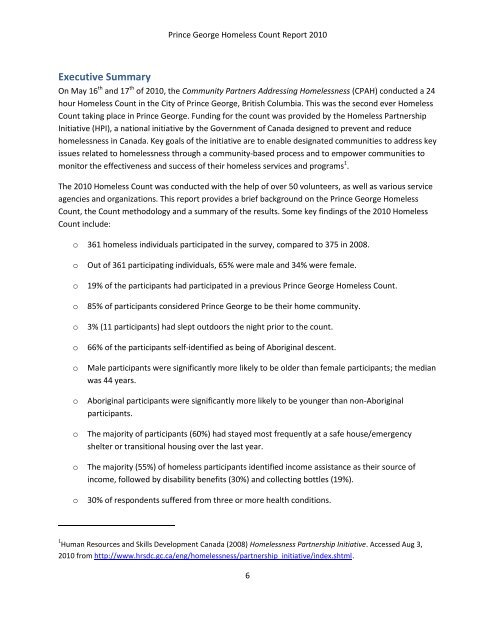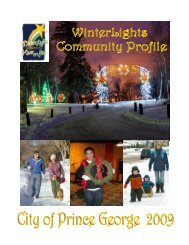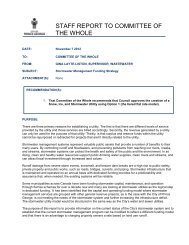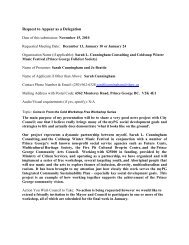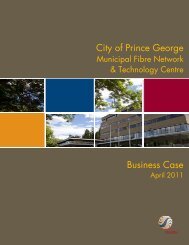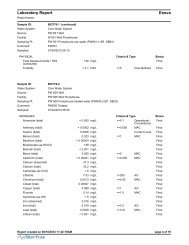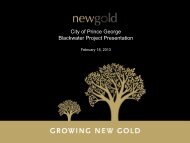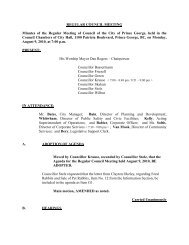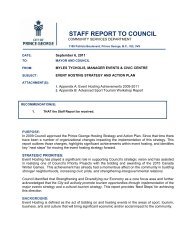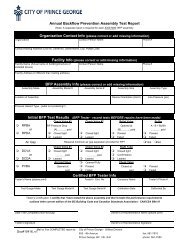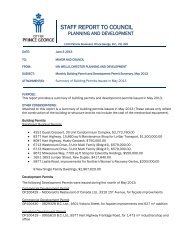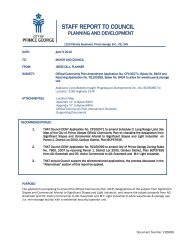Homeless Count Tables - City of Prince George
Homeless Count Tables - City of Prince George
Homeless Count Tables - City of Prince George
Create successful ePaper yourself
Turn your PDF publications into a flip-book with our unique Google optimized e-Paper software.
Executive Summary<br />
<strong>Prince</strong> <strong>George</strong> <strong>Homeless</strong> <strong>Count</strong> Report 2010<br />
On May 16 th and 17 th <strong>of</strong> 2010, the Community Partners Addressing <strong>Homeless</strong>ness (CPAH) conducted a 24<br />
hour <strong>Homeless</strong> <strong>Count</strong> in the <strong>City</strong> <strong>of</strong> <strong>Prince</strong> <strong>George</strong>, British Columbia. This was the second ever <strong>Homeless</strong><br />
<strong>Count</strong> taking place in <strong>Prince</strong> <strong>George</strong>. Funding for the count was provided by the <strong>Homeless</strong> Partnership<br />
Initiative (HPI), a national initiative by the Government <strong>of</strong> Canada designed to prevent and reduce<br />
homelessness in Canada. Key goals <strong>of</strong> the initiative are to enable designated communities to address key<br />
issues related to homelessness through a community-based process and to empower communities to<br />
monitor the effectiveness and success <strong>of</strong> their homeless services and programs 1 .<br />
The 2010 <strong>Homeless</strong> <strong>Count</strong> was conducted with the help <strong>of</strong> over 50 volunteers, as well as various service<br />
agencies and organizations. This report provides a brief background on the <strong>Prince</strong> <strong>George</strong> <strong>Homeless</strong><br />
<strong>Count</strong>, the <strong>Count</strong> methodology and a summary <strong>of</strong> the results. Some key findings <strong>of</strong> the 2010 <strong>Homeless</strong><br />
<strong>Count</strong> include:<br />
o 361 homeless individuals participated in the survey, compared to 375 in 2008.<br />
o Out <strong>of</strong> 361 participating individuals, 65% were male and 34% were female.<br />
o 19% <strong>of</strong> the participants had participated in a previous <strong>Prince</strong> <strong>George</strong> <strong>Homeless</strong> <strong>Count</strong>.<br />
o 85% <strong>of</strong> participants considered <strong>Prince</strong> <strong>George</strong> to be their home community.<br />
o 3% (11 participants) had slept outdoors the night prior to the count.<br />
o 66% <strong>of</strong> the participants self-identified as being <strong>of</strong> Aboriginal descent.<br />
o Male participants were significantly more likely to be older than female participants; the median<br />
was 44 years.<br />
o Aboriginal participants were significantly more likely to be younger than non-Aboriginal<br />
participants.<br />
o The majority <strong>of</strong> participants (60%) had stayed most frequently at a safe house/emergency<br />
shelter or transitional housing over the last year.<br />
o The majority (55%) <strong>of</strong> homeless participants identified income assistance as their source <strong>of</strong><br />
income, followed by disability benefits (30%) and collecting bottles (19%).<br />
o 30% <strong>of</strong> respondents suffered from three or more health conditions.<br />
1 Human Resources and Skills Development Canada (2008) <strong>Homeless</strong>ness Partnership Initiative. Accessed Aug 3,<br />
2010 from http://www.hrsdc.gc.ca/eng/homelessness/partnership_initiative/index.shtml.<br />
6


